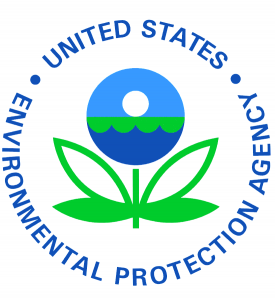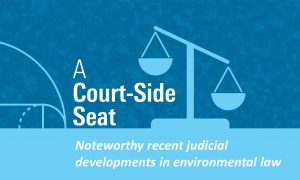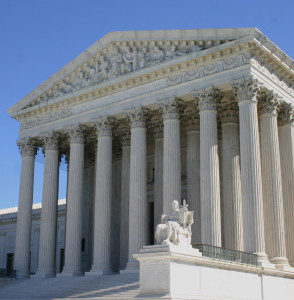It is clear that these have been busy months for federal environmental regulators, especially those working at EPA, the federal departments and the Council on Environmental Quality. Even the Department of Agriculture has found itself coping with greenhouse gases (GHG) issues in its administration of the laws applicable to agriculture and the national forests. The ambitious scope of the current “all of government” approach may be discerned after learning how many disparate federal agencies are employed in implementing this policy. So many actions have been proposed or completed that some state officials are experiencing “comment fatigue” because they are being overwhelmed by the scope, size, and complexity of these federal initiatives. The Environmental Protection Agency is, of course, at the forefront of these actions and activities, as described below.
Articles Tagged with clean water act
New Case Law Update: Mountain Valleys, Chevron Deference and a Long-Awaited Resolution on the Sacketts’ Small Lot
This is a brief roundup of recent federal court environmental and regulatory law decisions from the federal courts over the past few months, including the much anticipated ruling in Sackett, et ux., v, Environmental Protection Agency.
The EPA and the Corps of Engineers Propose Another Revised Definition of “Waters of the United States”
On December 7, 2021, the most recent proposed revision to the Clean Water Act’s term, “Waters of the United States” was published in the Federal Register. (See 86 FR 69372.) Comments on this proposal must be submitted by February 7, 2022. This term controls the scope of federal regulatory powers in such programs as the development of water quality standards, impaired waters, total maximum daily loads, oil spill prevention, preparedness and response plans, state and tribal water quality certification programs, the National Pollutant Discharge Elimination System (NPDES) permit program, and the Corps of Engineers’ dredge and fill program. The Environmental Protection Agency (EPA) and the Corps of Engineers have jointly drafted this comprehensive proposed rule, which also responds to President Biden’s Executive Order 13990, issued in January 2021.
Still Going, After All This Time: the Sacketts, EPA and the Clean Water Act
On August 16, 2021, the U.S. Court of Appeals for the Ninth Circuit affirmed the lower court’s ruling that the Idaho property of Michael and Chantell Sackett was a regulated wetlands under the then-controlling 1977 EPA rules defining “waters of the United States,” and that the Sacketts dredging and filling of their property was subject to regulation by the U.S. Army Corps of Engineers or EPA. EPA’s case, as it has been for many years, was based on 2008 EPA and Corps inspection reports and Justice Kennedy’s “significant nexus” test as the controlling opinion in the 2006 Supreme Court case, Rapanos v. United States. The Sacketts’ argument was that the text of the Clean Water Act, as interpreted by Justice Scalia and three other Justices, was controlling, but for several years, the Ninth Circuit has relied on Justice Kennedy’s opinion in these CWA controversies. The court’s opinion expressed considerable sympathy for the Sacketts as they negotiated the thicket of EPA’s regulatory processes, but it could not disregard circuit precedent. A few years ago, the Supreme Court ruled, in a unanimous decision, that EPA’s then extant administrative compliance orders were arbitrary and capricious. (See Sackett v. US, 566 US 120 (2015).) After that decision, the case was remanded to the federal district court, where it lingered for several more years.
It will be interesting to see if there will be another Supreme Court challenge to the Ninth Circuit’s disposition of the Sacketts’ Clean Water Act jurisdictional arguments.
A Court-Side Seat: Guam’s CERCLA Claim Allowed, a “Roundup” Verdict Upheld, and Judicial Process Privilege Lost
This is a brief account of some of the important environmental and administrative law cases recently decided.
THE U.S. SUPREME COURT
BP PLC, et al. v Mayor and City of Baltimore
The issue the court confronted was a procedural matter: Can the defendant energy companies use the federal removal statutes (see 28 USC Section 1442) to remove a state law climate change lawsuit to federal court? Here, a group of energy companies were sued by the mayor and city council of Baltimore in state court, where they alleged that the defendants had concealed the adverse environmental effects of the fossil fuel products they promoted and sold in Baltimore City. Several similar lawsuits have been filed in many state courts, where typically it is alleged that the defendants can be sued on various common law theories. Rather than defend these cases in state court, the defendants have sought to remove these cases to federal court because climate change liability appears to be an issue that should be settled at the federal level. These efforts have been unsuccessful, with most federal trial and appellate courts holding that the reasons cited for removal (oftentimes the federal officer removal statute) have not been persuasive. In this case, both the Maryland federal district court and the U.S. Court of Appeals held they had no jurisdiction to authorize removal, and thus returned the case to the state court. Noting that the U.S. Court of Appeals for the Seventh Circuit ruled that a removal action could be countenanced under Section 1442, thus creating a circuit split, the Supreme Court held that a straightforward reading of the removal statute empowers the reviewing court to examine all theories for removal that a district court has rejected. Consequently, the Court remanded the case to the Fourth Circuit where it can decide, “in the first instance,” whether there actually exist grounds to remove this case to federal court.
A Court-Side Seat: Butterflies, Salt Marshes and Methane All Around
Our latest summary of some recent developments in the courts and the federal agencies includes a unique case involving salt marshes adjacent to San Francisco Bay.
Environmental and Regulatory Highlights of the Fall 2019 Unified Agenda of Regulatory Actions
 In late December, the Office of Management and Budget (OMB) released the “Fall 2019 Unified Agenda of Regulatory Actions” just a few days before the Calendar turned to the year 2020. (It should be noted that the Spring Agenda was not released until June 24, 2019.) Individual agency agendas were published in the Federal Register by several agencies and executive departments on December 26, 2019. The entire agenda, which is a survey of all current and projected rule-making actions that federal agencies and departments are planning over the next 12 months, is available at such government websites as regulations.gov. The Agenda provides valuable insights into the actions these agencies believe to be most important. This survey will largely concentrate on environmental regulatory developments, although other matters are worth noting.
In late December, the Office of Management and Budget (OMB) released the “Fall 2019 Unified Agenda of Regulatory Actions” just a few days before the Calendar turned to the year 2020. (It should be noted that the Spring Agenda was not released until June 24, 2019.) Individual agency agendas were published in the Federal Register by several agencies and executive departments on December 26, 2019. The entire agenda, which is a survey of all current and projected rule-making actions that federal agencies and departments are planning over the next 12 months, is available at such government websites as regulations.gov. The Agenda provides valuable insights into the actions these agencies believe to be most important. This survey will largely concentrate on environmental regulatory developments, although other matters are worth noting.
U.S. Supreme Court Oral Arguments: Maritime Charters and the Specter of a New Permitting Regime
Clean Water Act Cases: Of Irrigation and Navigability
 The federal courts have recently decided two significant Clean Water Act (CWA) cases: State of Georgia, et al. v. Wheeler, where the US District Court for the Southern District of Georgia held that the 2015 rulemaking proceeding of EPA and the U.S. Army Corps of Engineers redefining the term “Waters of the United States” in the CWA violated the Act as well as the Administrative Procedure Act; and the Ninth Circuit’s decision in Pacific Coast Federation of Fishermen’s Associations, et al. v. Glaser, where the appeals court ruled that the lower court erroneously interpreted a CWA NPDES permitting exception involving agricultural return flows.
The federal courts have recently decided two significant Clean Water Act (CWA) cases: State of Georgia, et al. v. Wheeler, where the US District Court for the Southern District of Georgia held that the 2015 rulemaking proceeding of EPA and the U.S. Army Corps of Engineers redefining the term “Waters of the United States” in the CWA violated the Act as well as the Administrative Procedure Act; and the Ninth Circuit’s decision in Pacific Coast Federation of Fishermen’s Associations, et al. v. Glaser, where the appeals court ruled that the lower court erroneously interpreted a CWA NPDES permitting exception involving agricultural return flows.
As Some States Use the Clean Water Act to Delay Energy Projects, EPA Issues New CWA 401 Guidance
In just the past few weeks, three states have used their Clean Water Act 401 authority to delay, for an indefinite period, FERC-authorized pipeline expansion projects. On May 6, 2019, the Oregon Department of Environmental Quality denied, without prejudice, Jordan Cove’s application for a Section 401 water quality certification. Jordan Cove plans to build an LNG export terminal at Coos Bay, Oregon, if it can obtain the necessary federal and permits. Under Section 401(a) of the Clean Water Act, any applicant for a federal permit to conduct any activity, including the operation of facilities which may result in any discharge into the navigable waters, shall provide the permitting agency a certification from the State in which the discharge may originate that any such discharge will comply with the applicable provisions of the Clean Water Act, including effluent limitations and state water quality standards. The States have a “reasonable time”—which shall not exceed one year after the receipt of the 401 application—in which to act, or the state’s authority may be waived by this inaction. The Oregon DEQ concluded that Jordan Cove has not demonstrated that its project, as presently configured, will satisfy state water quality standards. The 401 applications submitted by Transcontinental Gas Pipe Line Co. (Transco) to the New Jersey Department of Environmental Protection and the New York State Department of Environmental Protection were similarly rejected without prejudice on May 15, 2019 (New York) and June 5, 2019 (New Jersey). This use of the states’ 401 authority has frustrated plans to build and operate LNG pipelines around the country.
 Gravel2Gavel Construction & Real Estate Law Blog
Gravel2Gavel Construction & Real Estate Law Blog




